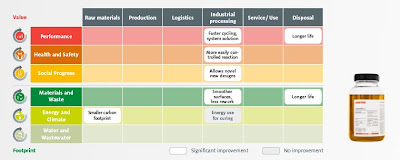Having spent a lot of time on this blog talking about the new generation of the GRI Guidelines and the G4 Exposure Draft, and speculating about what it will look like when it is actually launched, it is now time for the talking to stop and the action to begin, as we enter the countdown phase for the G4 launch. It's time for everyone to start placing bets as the exact format for the G4 launch is being kept well under wraps. If you are not in Amsterdam on May 22-24, to hear the first exposure of the G4 draft, and engage with 1,500 or more sustainability professionals, consultants, commentators, academics, regulators, activists and optimists at the Innovation, Information, Integration GRI Conference, you will be missing out on THE sustainability event of the 2013 calendar. Download the conference agenda here. Plus, if you attend, you'll get to meet all our online friends at the TWEET-UP, which will be at 12:00 noon on Wednesday 22nd May, a unique opportunity to put all those Twitter handles to Twitter faces.
One of the star attractions of the conference will, of course, be the first exposure of the G4 guidelines and the proposals for adopting them as the reporting journey moves forward. The G4 track runs through the conference, starting with the launch at the end of Day 1, running through Day 2 and finishing up on Day 3. If you attend all these sessions, you will become a true G4 expert and be able to advise your company on its reporting journey going forward.
Day One Wednesday 22nd May
17:30 G4 Launch
"This plenary will showcase the G4 development process and present the views of different stakeholders on how G4 will help advance organizational reporting and transparency." Speakers are: Denise Esdon, Ernst & Young; Karin Ireton, Standard Bank Group; Mervyn King, IIRC; Roel Nieuwenkamp, Director Trade Policy at Dutch Ministry of Economic Affairs; Herman Mulder, Chairman GRI
Day Two Thursday 23rd May
09:00: G4 Content Briefing: Jo Confino of the Guardian and Nelmara Arbex of the GRI will introduce the G4 guidelines
10:00: Defining Report Content: Material Aspects and Boundaries discussion will be moderated by Simon Longstaff, St. James Ethics Centre
Disclosure
11:30: Disclosure on Management Approach (DMA) discussion will be moderated by Judy Kuszewski, SustainAbility
14:30:
Governance and Remuneration discussion will be moderated by Christianna Wood, Chairman of the Board of Governors of the International Corporate Governance Network
16:00:
Supply Chain discussion, moderated by Simon Longstaff, St. James Ethics Centre
Day Three Friday 24th May
09:00: Greenhouse Gas Emissions reporting discussion, moderated by Simon Longstaff... again.
In addition to the G4 track, there are "Trends in Reporting" sessions, Regional Overviews by Delegations from around the world, Policy and Regulation sessions and Learning Sessions, such as "First Time Reporting Made Easy" with Crystal Crawford, Corporate Responsibility Specialist of Liberty Global, whose report I featured on the CSR Reporting blog a while ago. (10:00 Thursday 23rd, Day Two)
In other words, plenty of interesting perspectives, updates, networking, discussion, insight, information, innovation and integration. I am looking forward to seeing absolutely loads of old, new, offline, online and bothline friends, colleagues and sustainability movers-and-shakers at the conference.
In the meantime, before you get to Amsterdam, there is something else you can be doing.
As you may know, the voting period for GRI’s Next Generation Competition began on Wednesday 20th March, on GRI’s Facebook page. More than 60,000 Facebook users have been reached, and more than 3,000 votes (or "likes") for the different posters presented have already been received. The competition was designed to encourage young professionals up to age 30 to engage with the sustainability agenda and compete for the opportunity to be part of a landmark conference and turning point in Sustainability Reporting history. The challenge was to design a poster that promotes an inspiring concept or message to encourage people and/or companies to accelerate the transition towards a sustainable global economy, while relating to one or all of the key words that make-up the theme of the GRI Global Conference: Information, Integration, Innovation.
The Facebook album of the 25 posters submitted can be viewed on Facebook via this link: http://on.fb.me/16006K9, and you are invited to "like" the posters you believe best reflect and inspire sustainability. Public voting closes on 10th April, which means your chance to vote for the top 10 is quickly approaching!
 |
| See the full selection of posters, and vote for your faves, on Facebook! |
Once determined by public voting, the top 10 posters will be submitted to an international jury (which includes me, myself and I, as well as other sustainability pros) for a shortlist selection of the top three posters. The authors of these top three posters will be invited to join GRI (and us) at the Global Conference in May and conference delegates will select the overall winner. This 1st Prize winner will be invited to give a speech at the closing plenary session of the conference, to explain her or his entry and inspire the international audience! Who knows, one of these poster-masters may well be a global corporate sustainability leader of the future...wouldn't you like to be able to say you had a hand in her or his professional development? Sure you would... so take a look, vote and see you at the GRI conference!
PS: I will be on the lookout for the best ice-cream in Amsterdam, so all suggestions welcome!
PS: I will be on the lookout for the best ice-cream in Amsterdam, so all suggestions welcome!
elaine cohen, CSR consultant, winning (CRRA'12) Sustainability Reporter, HR Professional, Ice Cream Addict. Author of Sustainability Reporting for SMEs: Competitive Advantage Through Transparency AND CSR for HR: A necessary partnership for advancing responsible business practices Contact me via www.twitter.com/elainecohen or via my business website www.b-yond.biz (Beyond Business Ltd, an inspired CSR consulting and Sustainability Reporting firm)






















